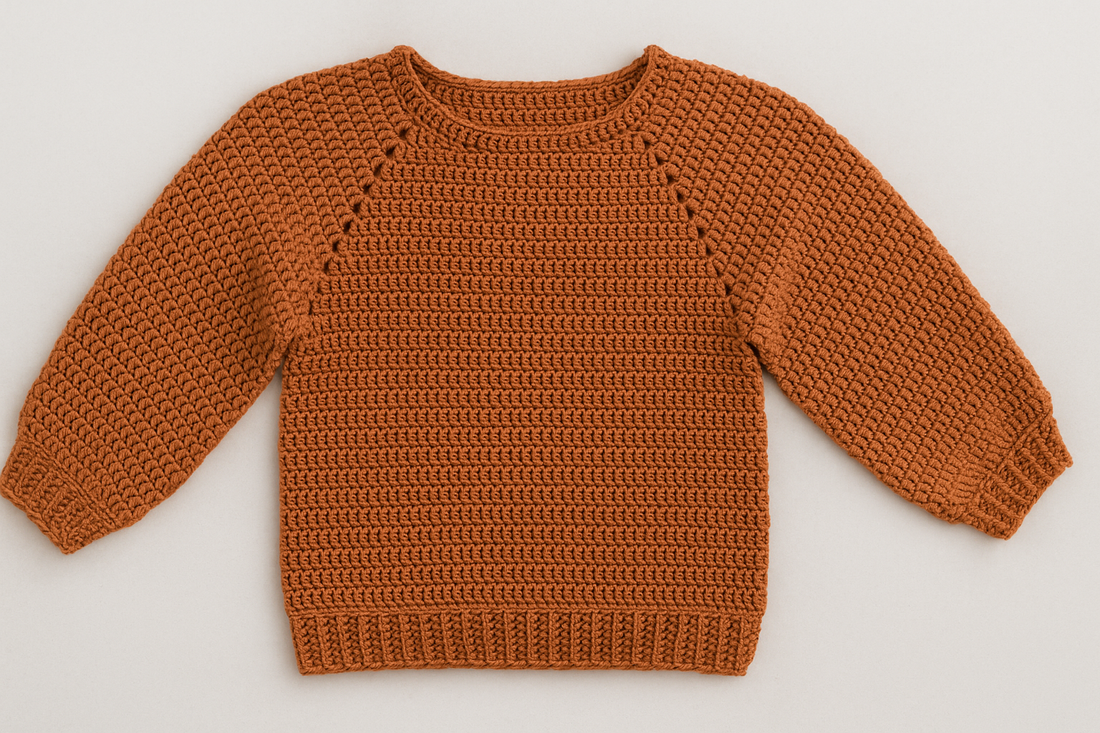
How to calculate the stitch distribution for a crochet top-down sweater
Share
If you're thinking about crocheting a top-down sweater , one of the key steps is knowing how to divide the initial yoke stitches between the front, back, and sleeves. And, above all, how to adapt the pattern so the neckline is round or square , depending on your preferred style.
In this article, we explain the step-by-step method so you can design your own crochet top-down sweater from the neckline to the bottom, with a perfect finish.
What does “top down” mean in crochet?
A top-down sweater is knitted from the top (the neck) to the bottom, either in one piece or in several pieces that are then joined together. This method is ideal if you want to test the garment while knitting, adjust the length, or easily customize the design.

✨ How to divide the yoke stitches in crochet
Once you have the total number of chains to form the neck , you must divide those stitches into four areas:
- Front
- Back
- Left sleeve
- Right sleeve
You'll also need four increase stitches , one at each corner of the yoke (i.e., between the body and sleeves). These stitches are essential for the garment to grow properly downward.
📏 Classic method for distributing points
The most common system follows this proportion:
- 3 parts for the forward
- 3 parts for the back
- 2 parts for each sleeve
- + 4 corner stitches for increases
Practical example:
Imagine you start with 88 chains for the neck:
- Subtract the 4 points from the corners → 88 - 4 = 84 points to distribute
- Divide 84 by 10 (3+3+2+2) → 8.4 points per part
- Approximate distribution:
-
- Forward: 3 × 8 = 24 points
- Back: 3 × 8 = 24 stitches
- Right sleeve: 2 × 8 = 16 stitches
- Left sleeve: 2 × 8 = 16 stitches
- Corners: 4 points
✅ Total: 84 + 4 = 88 points!
🔁 From there, you knit in the round and increase in each of the 4 corner stitches.
🎯 How to make a round or square neck?
This is where the key difference lies: although the stitch distribution is the same, the final shape of the neck depends on how you work the first few rows.
- Square neck top down
It is the simplest and most direct method, ideal if you are just starting out:
- From the first round, you increase only in the 4 corner stitches .
- This creates a square or rectangular shaped yoke .
- The neckline has marked diagonal lines between the body and sleeves.
👉 It is perfect for basic designs and beginner patterns.
- Round neck top down
If you want a softer, more ergonomic, rounder neck, you can apply one of these techniques:
1. Short back rows
Before closing the yoke in the round, knit several short rows on the back. This raises the back slightly and makes the neckline fall forward more naturally.
2. More evenly distributed increases
Instead of increasing only in the four corner stitches, you can distribute some increases throughout the yoke, especially in the front. The result is a curvier, less angular shape.
3. Separate collar
Another option is to knit a ribbed or decorative collar first and then pick up stitches to begin the yoke. This allows more freedom in shaping the neckline.
Comparison: square neck vs. round neck
| Feature | Square Neck | Round Neck |
|---|---|---|
| Difficulty | Very easy | It requires more technique |
| Method | Increases in 4 corners | Short turns or spread increases |
| Style | More structured, clean cut | Softer, more ergonomic and more flattering |
| Ideal for | Basic or beginner patterns | Custom or more advanced designs |
In summary
If you already have the number of chains to start your crochet top-down sweater , now you know how to distribute the stitches between the front, back and sleeves, and how to adapt the construction so that the neck is round or square .
Whether you're looking for a simple or more elaborate design, this method gives you the freedom to create and adapt your own crochet patterns.
🛒 Want to start your sweater now?
Find the perfect balls of yarn for your next knitting project in our online store:
👉 Buy balls of yarn at Idealium
We have wools and cottons for every style, and we're here to help you every step of the way!
